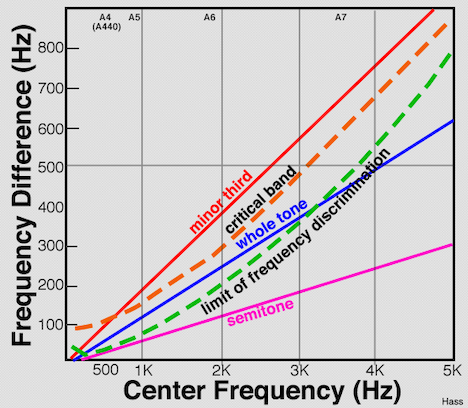Chapter One: An Acoustics Primer

15. How do we perceive pitch? | Page 2
Further psychoacoustic phenomena related to pitch perception
In the range of 20 to 2000 Hz, the ear has the ability to fuse harmonically-related frequencies into a single entity (i.e., a single note with a particular timbre) with a fundamental frequency, even if the fundamental is missing.
When we listen to a violin section, we are hopefully hearing numerous instruments playing approximately the same pitch, with some very slight differences in frequency (called chorusing) that give the sound a depth and richness beyond what a single instrument would produce. But just how far out of tune can these simultaneous "unison" notes be before we hear them as separate pitches? As mentioned previously, a slight difference in frequency will lead to the phenomenon of beating. We perceive pure (sine wave) mistuned notes as a single chorused or fused pitch up to the limit of frequency discrimination, a curve (shown below) that is about a 7% difference for lower frequencies (e.g. 500 Hz) up to 15% for higher ones (e.g. 5 kHz). Beyond this limit, we hear two separate tones. At the very point of such a perceptual separation lies an area of tonal roughness. When the interval is great enough to hear easily as two separate pitches, that is referred to as tonal smoothness. Complex, non-sine waveforms are easier to discriminate, due to the greater number of rough, "out of tune" partials.

Critical band:
While a single pitch may maximally stimulate a specific spot on the basilar membrane, it also stimulates some adjacent hair cells as well. These lie within what is called the critical band. Harvey Fletcher, psychoacoustics pioneer, discovered that different parts of the basilar membrane resonate more strongly at different frequencies and he divided the membrane up into 24 overlapping areas or bands for purposes of measurement. Pitches that are close in frequency may share some hair cells in common and lie within the same band, which is theorized to cause intervallically close tones to sound more complex than more widely separated tones. The intervalic width of these bands vary by register, as listed in this chart and shown on the graph above. The bandwidth is a larger percentage of the frequencies of two low tones (approximately 100 Hz), and a smaller percentage of the frequencies in a higher register (approximately 3500 Hz). For example, a critical band centered on A440 will be 110 Hz wide, giving it a range from 390 Hz to 500 Hz, or close to a major 3rd. The graph above shows how that bandwidth varies with frequency. Interestingly, despite Fletcher's divisions of the basilar membrane into 24 bands or filters, it is we who form our own bands centered on the frequencies of greatest interest, similar to the cocktail party effect, where we are able to tune in and tune out individual aural stimuli, such as conversations, in a complex auditory environment.
Another applicable phenomenon is that when two sounds of equal loudness are close in pitch, thereby in the critical band, their combined loudness will be only slightly greater than one of them alone. Hiring a second violinist to play in unison with the first will not double the perceived loudness of the notes because (hopefully) their unisons fall within the critical bands.
Our perception of pitch is also affected by the duration and intensity of a sound. Sustained sounds above 2 kHz may be perceived as rising in pitch as their intensity increases, whereas sounds below 2 kHz may be perceived as dropping in pitch. I might theorize that this phenomenon contributes to the intonation difficulties all high school band or choral conductors experience with changes in dynamics.
In preparing this article it became clear from the existing research that the complete and exact mechanism for our extraordinary pitch resolution and discrimination is not completely understood and is still being investigated. The placement theory coupled with the critical band concept does not completely explain our ability to detect the minute frequency changes we are capable of.